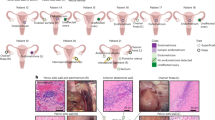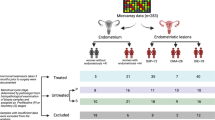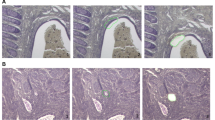Abstract
Endometriosis affects approximately 12% of reproductive-age women and is currently diagnosed using invasive laparoscopic sur-gery. Differences in gene expression in the eutopic endometrium between women with and without endometriosis have been reported, and determining the reproducibility of these genetic differences in the endocervical epithelium would represent an important step toward developing novel diagnostic strategies. In this study, we analyzed gene expression in the endocervical epithelium in women with and without moderate or severe endometriosis. Using RT2 Profiler PCR Arrays, we analyzed gene expression in endocervical epithelial cells from women with deep endometriosis (n = 4) and healthy women (n =6). Nine genes were identified as being upregulated:5 cell cycle genes (cyclin Bl [CCNBI], cyclin Gl [CCNGI], cullin I [CULI], general tran-scription factor IIH, Polypeptide I [GTF2HI ], and proliferating cell nuclear antigen [PCNA]), 3 cytokinegenes (C3, chemokine (C-C motif) ligand 21 [CCL2I], and chemokine (C-X-C motif) ligand 14 [CXCLI4]) and I gene related to dendritic cell pathways (ICAM2), showingthat differential gene expression is present in the endocervical epithelium of women with deep endometriosis.
Similar content being viewed by others
References
Giudice LC, Kao LC. Endometriosis. Lancet. 2004;364(9447):1789–1799.
Ota H, Tanaka T. Integrin adhesion molecules in the endometrial glandular epithelium in patients with endometriosis or adenomyo-sis. J Obstet Gynaecol Res. 1997;23(5):485–491.
Donnez J, Smoes P, Gillerot S, Casanas-Roux F, Nisolle M. Vas-cular endothelial growth factor (VEGF) in endometriosis. Hum Reprod. 1998;13(6):1686–1690.
Nap AW, Dunselman GA, de Goeij AF, Evers JL, Groothuis PG. Inhibiting MMP activity prevents the development of endometriosis in the chicken chorioallantoic membrane model. Hum Reprod. 2004;19(10):2180–2187.
Schor E, da Silva ID, Sato H, Baracat EC, Giräo MJ, de Freitas V. p27Kipl is down-regulated in the endometrium of women with endometriosis. Fertil Steril. 2009;91(3):682–686.
Vinatier D, Cosson M, Dufour P. Is endometriosis an endometrial disease? Eur J Obstet Gynecol Reprod Biol. 2000;91(2):113–125.
Meresman GF, Bilotas M, Abello V, Buquet R, Tesone M, Sueldo C. Effects of aromatase inhibitors on proliferation and apoptosis in eutopic endometrial cell cultures from patients with endometriosis. Fertil Steril. 2005;84(2):459–463.
De Carvalho CV, Nogueira-De-Souza NC, Costa AM, et al. Genetic polymorphisms of cytochrome P450cl7alpha (CYP17) and progesterone receptor genes (PROGINS) in the assessment of endometriosis risk. Gynecol Endocrinol. 2007;23(1):29–33.
Butts CL, Bowers E, Horn JC, et al. Inhibitory effects of progesterone differ in dendritic cells from female and male rodents. Gend Med. 2008;5(4):434–447.
Schulke L, Berbic M, Manconi F, Tokushige N, Markham R, Fraser IS. Dendritic cell populations in the eutopic and ectopic endometrium of women with endometriosis. Hum Reprod. 2009; 24(7):1695–1703.
Al-Sabbagh M, Lam EW, Brosens JJ. Mechanisms of endometrial progesterone resistance. Mol Cell Endocrinol. 2012;358(2):208–215.
Aghajanova L, Tatsumi K, Horcajadas JA, et al. Unique transcrip-tome, pathways, and networks in the human endometrial fibro-blast response to progesterone in endometriosis. Biol Reprod. 2011;84(4):801–815.
Burney RO, Talbi S, Hamilton AE, et al. Gene expression analysis of endometrium reveals progesterone resistance and candidate susceptibility genes in women with endometriosis. Endocrinol-ogy. 2007;148(8):3814–3826.
Kao LC, Germeyer A, Tulac S, et al. Expression profiling of endometrium from women with endometriosis reveals candidate genes for disease-based implantation failure and infertility. Endo-crinology. 2003;144(7):2870–2881.
Speroff L, Fritz MA. Clinical Gynecologic Endocrinology and Infertility. Philadelphia, PA:Lippincot Williams and Wilkins; 2005.
Wan C, Latter JL, Amirshahi A, et al. Progesterone activates multiple innate immune pathways in Chlamydia trachomatis-infected endocervical cells. Am J Reprod Immunol. 2014;71(2):165–177.
Yoo YA, Son J, Mehta FF, DeMayo FJ, Lydon JP, Chung SH. Progesterone signaling inhibits cervical carcinogenesis in mice. Am J Pathol. 2013;183(5):1679–1687.
Arslan SY, Yu Y, Burdette JE, et al. Novel three dimensional human endocervix cultures respond to 28-day hormone treatment. Endocrinology. 2015;156(4):1602–1609.
Nnoaham KE, Hummelshoj L, Webster P, et al. World Endometriosis Research Foundation Global Study of Women’s Health consortium. Impact of endometriosis on quality of life and work productivity:a multicenter study across ten countries. Fertil Steril. 2011;96(2):366–373. e8.
Tamaresis JS, Irwin JC, Goldfien GA, et al. Molecular Classification of endometriosis and disease stage using high-dimensional genomic data. Endocrinology. 2014;155(12):4986–4999.
Berkkanoglu M, Arici A. Immunology and endometriosis. Am J Reprod Immunol. 2003;50(1):48–59.
Othman Eel-D, Hornung D, Salem HT, Khalifa EA, El-Metwally TH, Al-Hendy A. Serum cytokines as biomarkers for nonsurgical prediction of endometriosis. Eur J Obstet Gynecol Reprod Biol. 2008;137(2):240–246.
Seeber B, Sammel MD, Fan X, et al. Panel of markers can accu-rately predict endometriosis in a subset of patients. Fertil Steril. 2008;89(5):1073–1081.
Harada T, Kaponis A, Iwabe T, et al. Apoptosis in human endometrium and endometriosis. Hum Reprod Update. 2004;10(1):29–38.
Kabut J, Kondera-Anasz Z, Sikora J, Mielczarek-Palacz A. Levels of complement components iC3b, C3c, C4, and SC5b-9 in peritoneal fluid and serum of infertile women with endometriosis. Fertil Steril. 2007;88(5):1298–1303.
Flores I, Rivera E, Ruiz LA, Santiago Ol, Vernon MW, Appleyard CB. Molecular profiling of experimental endometriosis identified gene expression patterns in common with human disease. Fertil Steril. 2007;87(5):1180–1199.
Chand AL, Murray AS, Jones RL, Hannan NJ, Salamonsen LA, Rombauts L. Laser capture microdissection and cDNA array anal-ysis of endometrium identify CCL16 and CCL21 as epithelial -derived inflammatory mediators associated with endometriosis. Reprod Biol Endocrinol. 2007;5:18.
Augsten M, Sjöberg E, Frings O, et al. Cancer-associated fibro-blasts expressing CXCL14 rely upon NOSl-derived nitric oxide signaling for their tumor-supporting properties. Cancer Res. 2014;74(11):2999–3010.
Tang L, Wang TT, Wu YT, Zhou CY, Huang HF. High expression levels of cyclin Bl and Polo-like kinase 1 in ectopic endometrial cells associated with abnormal cell cycle regulation of endometriosis. Fertil Steril. 2009;91(4):979–987.
Willis B, Barton P, Pearmain P, Bryan S, Hyde C. Cervical Screening programmes:can automation help? Evidence from sys-tematic reviews, an economic analysis and a Simulation model-ling exercise applied to the UK. Health Technol Assess. 2005; 9(13):1–207.
Stanic AK, Kim M, Styer AK, Rueda BR. Dendritic cells attenu-ate the early establishment of endometriosis-like lesions in a murine model. Reprod Sci. 2014;21(10):1228–1236.
Author information
Authors and Affiliations
Corresponding author
Rights and permissions
About this article
Cite this article
Kopelman, A., Girão, M.J.B.C., Bonetti, T.C.S. et al. Analysis of Gene Expression in the Endocervical Epithelium of Wonnen With Deep Endometriosis. Reprod. Sci. 23, 1269–1274 (2016). https://doi.org/10.1177/1933719116638179
Published:
Issue Date:
DOI: https://doi.org/10.1177/1933719116638179




